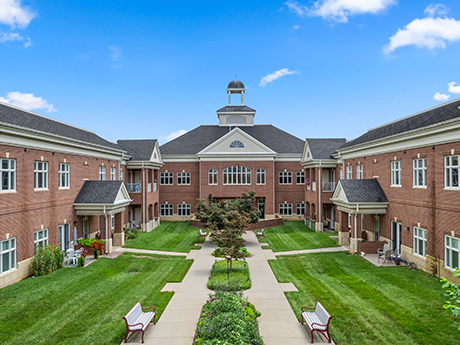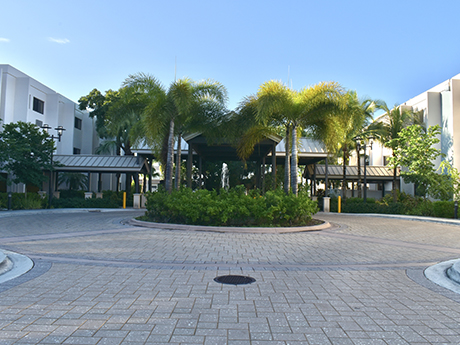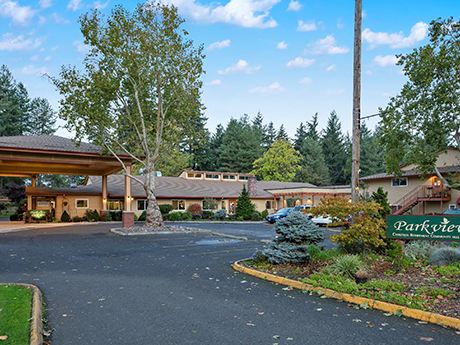Many nonprofit organizations will likely be forced to sell seniors housing properties and skilled nursing facilities over the next year after succumbing to years of high costs and slowly recovering occupancies. Several have already come to the closing table.
Smaller nonprofits — organizations that own one or two properties — have been especially hurt by the economic fallout from the COVID-19 pandemic that struck the seniors housing and care industry in early 2020. Numerous federal, state and local pandemic programs that provided support expired over the last two years. Meanwhile, interest rates remain relatively high for both long-term and short-term loans.
The eager buyers include for-profit organizations and some larger, more stable nonprofits. “The trend is accelerating and has not peaked,” says Bill Wilson, managing director at Lument, who is based in the firm’s office in Overland Park, Kansas.
A Difficult Decision
In March 2024, Parkview Christian Retirement Community in Portland, Oregon, sold its 6-acre Parkview campus to a for-profit buyer. The campus includes 115 independent living apartments as well as 62 assisted living units. Parkview is a relatively small nonprofit organization that had struggled to pay creditors. It owned just the single property it was named after.
The nonprofit had searched for another nonprofit organization that it could partner with to bring new resources to its operations. After an exhaustive search, it became clear no qualified, nonprofit buyer would emerge. It was eventually sold to an undisclosed for-profit buyer based on the West Coast.
“Whenever a nonprofit is struggling, its first goal is to find another nonprofit to merge with. Sometimes that is not feasible,” says Humair Sabir, managing director of the senior housing and care finance team at Ziegler, which served as financial advisor to Parkview. Sabir is based in San Diego.
These struggling nonprofits prefer to sell to a buyer that shares their mission of serving seniors before serving up profits to investors. “Selling to a for-profit buyer is the last thing they want to do,” says Sabir.
The sale has enabled Parkview to pay its creditors, says Sabir. The nonprofit will also be able to continue its mission of serving seniors locally by using the proceeds of the sale to provide other types of services.
That is “the best possible solution for our community,” says Jennifer Schultz, Parkview’s former executive director who now serves as a consultant for the Parkview campus, originally founded as the Oregon Baptist Retirement Home in 1944.
Facing a Multitude of Issues
Many nonprofit organizations that own seniors housing and care properties have struggled to make ends meet in the wake of the coronavirus pandemic.
“Nonprofits are dealing with wage increases, labor challenges, the pressure of low occupancy — particularly in skilled nursing — and the high cost of capital,” says Lisa McCracken, head of research and analytics for the National Investment Center for Seniors Housing & Care (NIC), based in Annapolis, Maryland.
These nonprofit seniors housing operators often performed better during the pandemic than their for-profit peers. They lost less occupancy, on average, at their properties and recovered more quickly. But small nonprofit organizations often have thinner balance sheets to draw from, less diversity of operations to diffuse problems and fewer economies of scale than larger seniors housing operators.
Many nonprofits are finally beginning to fill seniors housing units that had sat empty since the pandemic. In the third quarter of 2024, a healthy 89.9 percent of the units were occupied at seniors housing properties managed by nonprofit organizations, according to NIC MAP. That includes independent living, assisted living and memory care communities. That’s up more than two percentage points from lows during the pandemic.
For-profit seniors housing and care operators are taking even more time to recover lost occupancy. That’s because developers overbuilt for-
profit seniors housing just before the pandemic. At seniors housing communities managed by for-profit organizations, 85.1 percent of the units were occupied during the same period.
“Development has been suppressed for the last decade among the not-for-profits and just more recently in the last few years within the for-profit sector,” says McCracken.
Despite the dearth of new product that works to their advantage, small seniors housing operators have been particularly vulnerable during the years of high costs and low occupancies.
“There are benefits that come with greater scale — you’re often able to better weather difficult times,” says McCracken. “The not-for-profit sector has a higher proportion of smaller freestanding communities than the for-profit space.”
Wilson points out that there was a time when a nonprofit’s stand-alone facility filled a community need and did not experience significant competition. “That is no longer the case in many communities. They are fighting for residents, as well as staff, against competitors with much greater resources,” he says.
The operating pressures have continued to mount for nonprofits with many defaulting on loans, adds Wilson. “Default trends continued in 2024, with industry sources estimating that defaults remained above 8 percent for outstanding non-profit seniors housing bond issues.” That is several percentage points higher than the historical average.
That spells opportunity for seniors housing investors, says Laca Wong-Hammond, managing director and head of mergers and acquisitions for Lument and based in the firm’s Columbus, Ohio office.
Nonprofits have the ability to access tax-exempt bond financing that is not available to for-profit organizations. But for-profit buyers often have more scale and more capital available to invest from their own balance sheets than a typical nonprofit organization. For-profit organizations can also tap into equity from other capital partners such as private equity funds, says McCracken.
Larger operators can also use the scale of their operations to negotiate better terms with vendors, control costs and use their broader marketing platforms to help drive occupancy, emphasizes Ziegler’s Sabir.
Some nonprofits have also been hurt by their resistance to raise their prices for the seniors they serve, even as their own costs escalated. “While admirable, this tendency has amplified already significant operating pressures seen over the last several years,” says Wong-Hammond.
“Many non-profits took their charitable mission to great lengths in recent years,” says Kevin Beard, director of acquisitions and preservation for Chicago-based Evergreen Real Estate Group, a for-profit affordable housing developer. “They operated at significant losses in order to carry out their mission of housing seniors.”
In contrast, many for-profit owners of senior living facilities have pushed annual double-digit rate increases over the last few years, says Sabir.
Nonprofits can seek assistance. They have opportunities to leverage their mission-driven approach by accessing philanthropic funding and tax exemptions, says Jon Fletcher, senior vice president of Presbyterian Homes & Services, based in Roseville, Minn., one of the nation’s largest nonprofit senior living organizations.
But, in many cases, smaller nonprofit organizations have been so overwhelmed by operating losses that they can’t dedicate the resources they need for fundraising, says Sabir.
Funding shortfalls also make it more difficult for nonprofits to make capital improvements to their facilities.
“You now have quite a few nonprofit-owned properties that, from a facilities perspective, just cannot compete with newer product,” says Evergreen’s Beard. “Many of them were developed before the for-profit wave of seniors housing and are functionally obsolete, not just out of date.”
“A downward spiral ensues,” says Wong-Hammond. “It is extremely important for nonprofits to seize the initiative to invest in their physical plant, not just operations.”
Once a seniors housing community hits a certain point of distress, a struggling nonprofit is less likely to find another, more stable nonprofit organization to partner with.
That’s because once a property becomes financially distressed, the physical condition of the property often deteriorates as regular maintenance and capital expenditures get deferred. The occupancy rate and the reputation of the community can also suffer.
There are often significant debt requirements that may be in default. It often takes a lot of money to turn around a troubled property, and few nonprofit organizations have the capital to invest, or are willing to put their larger organization at risk, according to McCracken.
“Not paying attention to the writing on the wall can be a real disservice to the employees that work there, to residents and family members and really to the community at large,” says McCracken.
Nonprofits Join Forces
Smaller nonprofits that are not yet in financial distress may be able to form partnerships or “affiliations” with larger nonprofit organizations.
“While some outright sales by nonprofits are occurring, many are recognizing the benefits of affiliating with other nonprofits,” says Presbyterian Homes’ Fletcher.
In June 2024, Covenant Living Communities and Services became the owners of two continuing care retirement communities (CCRCs) in the Knoxville, Tenn., metropolitan area. Skokie, Ill.-based Covenant is among the nation’s top 10 nonprofit senior living organizations. It took possession of the two properties through an affiliation with nonprofit owner Shannondale Senior Living, formerly Presbyterian Homes of Tennessee.
Shannondale Senior Living has historically been a small but strong nonprofit organization. In 2021, amid the pandemic, it completed the demolition and replacement of the oldest units at Shannondale of Knoxville. The 60-acre site now includes just over 220 units of independent living and assisted living apartments, homes, and duplexes.
The second community, Shannondale of Maryville, includes more than 230 independent living, assisted living and skilled nursing apartments, homes and duplexes.

“Shannondale wasn’t in trouble from an occupancy perspective, but it knew that in the long term it needed a stronger backstop,” says Jay Hibbard, chief growth and communications officer for Covenant.
“Covenant Living’s reputation and sound financial practices will provide additional strength and access to resources for operational efficiencies, national contracts, management expertise, as well as capital improvements,” says Scott Phillips, president and CEO of Shannondale.
Under terms of the affiliation, Covenant assumed the debt on the property and will operate and manage the properties. The 135 employees at the two properties will join the staff at Covenant.
Since 2019, Covenant Living also added Covenant Living at Inverness in Tulsa, Oklahoma, Three Crowns Park in Evanston, Illinois and Covenant Living of Keene in Keene, New Hampshire.
When Covenant considers affiliating with another nonprofit that owns seniors housing or care properties, it considers how long it might take for those properties to recover to a profitable net operating margin in the range of 6 to 8 percent annually.
“If you can’t get to a reasonable net operating margin, you wonder if it’s worth it,” says Hibbard. “There have been plenty of deals that we have not moved forward with because the properties were just too far gone.”
Skilled Nursing Most at Risk
Small nonprofits that own one or two skilled nursing facilities have been under extreme pressure.
“With few exceptions, a single-site, freestanding nursing home in a competitive market is going to be very challenged,” says McCracken. It requires a strong organization to compete with larger organizations for residents and staff, she emphasizes. “There are some really sharp single-site organizations. But there are some definite benefits to scale.”
Because skilled nursing facilities require plenty of staff, they have suffered more than other seniors housing properties from staff shortages and rising costs.
“Skilled nursing is much more operationally intensive,” says Sabir. “It’s just much more expensive to run.”
Nursing homes owned by nonprofits have recently been more likely to fail than nursing homes overall. One-third of the nursing homes that closed in 2023 were owned and operated by nonprofit sponsors. But nursing homes owned by nonprofits account for less than a quarter (23 percent) of the 9,900 nursing homes in the U.S., not including facilities with less than 25 units, veterans homes or CCRCs.
“There are very few not-for-profits that are interested in expanding their nursing portfolio,” says McCracken.
However, for-profit buyers are very interested. “The market for skilled nursing facilities, especially for the for-profit buyers, is still pretty aggressive,” says Sabir. “There’s a lot of buyers out there. There’s a lot of consolidation.”
The number of sales of skilled nursing properties increased over the last two years even as interest rates and the cost of acquisition financing rose. Many dealmakers expect interest rates to stabilize over the coming year.
“[Dealmaking] is actually going to get even more aggressive,” says Sabir.
For-Profits Rush to Buy
Buyers have been eager to make acquisitions for seniors housing and care businesses. In March 2023, the nonprofit Epworth Village Retirement Community sold its CCRC in Hialeah, Florida, a suburb of Miami. The campus benefitted from strong occupancy and a history of healthy financial performance, according to Lument. For example, the skilled nursing units at the CCRC were 93 percent occupied before the sale. The sales process generated high demand, as Lument procured nine letters of intent.
The prices that investors are willing to pay for opportunistic properties like Epworth Village have inflated in recent years, along with rising operating costs and interest rates. A joint venture between Allarian Rehabilitation & Senior Living and Las Palmas Senior Living purchased the property.
“Construction costs have materially escalated, causing seniors housing construction starts to fall to their lowest level since 2010,” says Lument’s Wong-Hammond. “This creates an opportunity for owners of underperforming hard assets to sell at elevated prices.”
For-profit buyers have been willing to pay these elevated prices because they are still below current replacement costs, she says.
The board of directors of Epworth Village will use the proceeds from their sale to form a charitable foundation to continue its mission, according to Lument, which served Epworth Village as a sell-side investment banker.
The campus consists of Epworth Village, a 290-unit independent and assisted living community, and the Susanna Wesley Health Center, a 120-bed skilled nursing facility that is five-star rated by the Centers for Medicare & Medicaid Services.

Nonprofits Have Strengths
Despite the pressures small nonprofits face, they also possess some advantages. For starters, nonprofits tend to have more loyal residents who are less likely to move out.
“Often the strongest nonprofits are those with close ties to the community,” says Wilson. Many nonprofits also have religious affiliations that can help provide a stable source of residents, in addition to quality candidates for positions on the board of the nonprofit, she points out.
Nonprofits also tend to have more loyal employees.
“Nonprofit employees may be willing to accept lower compensation for the sake of advancing the organization’s mission,” says Wong-Hammond. However, in a highly competitive labor market, “even a tenured employee might be tempted to defect to a competitor.”
— Bendix Anderson

